Abstract
Possible protective effects of the agonist [D-Trp6]LH-RH (the D-tryptophan-6 analog of luteinizing hormone-releasing hormone) against testicular damage caused by cyclophosphamide (Cytoxan) were investigated in subhuman primates. Three adult male baboons (Papio anubis) were first subjected to normal semen evaluation by using electroejaculation. The average baseline count for the animals ranged from 95.7 X 10(6) to 585.7 X 10(6) sperm per ml with 90% normal forms and 85% motility with excellent rapid forward progression. After baseline evaluations, two of the animals were treated with daily subcutaneous injections of 0.5 mg of the agonist [D-Trp6]LH-RH. There was an initial rise in serum testosterone after 1 week, but testosterone fell to castration values at 1 month and continued at these levels during treatment with the agonist. There was also an initial rise in sperm concentration 1 month after treatment was started, but after 2 months the animals were azoospermic. After 13 weeks of therapy with [D-Trp6]LH-RH, these two baboons and a third untreated control animal were given cyclophosphamide at a dose of about 3 mg/kg of body weight per day for 4 months. The two animals pretreated with [D-Trp6]LH-RH, continued to receive this agonist until 1 week after the last dose of Cytoxan. In one of the two baboons treated with Cytoxan and the LH-RH agonist, the white blood count fell below 4000 per microliter, and the dose of Cytoxan had to be reduced to 1.5 mg/kg per day for 12 days. The control animal developed azoospermia after 4 months of treatment with cyclophosphamide, and serum testosterone increased while sperm count decreased. Four weeks after the agonist was stopped, serum testosterone in both animals pretreated with [D-Trp6]LH-RH returned to normal levels. The control animal showed a small amount of nonmotile sperm 2.5 months after cessation of treatment, but after 9 months remains oligospermic with poor sperm motility. In one of the animals treated with LH-RH agonist, semen analysis returned to normal pretreatment values 8 months after withdrawal of treatment. The other animal remains oligospermic 10 months after therapy, but the motility is improving. These preliminary results suggest that treatment with LH-RH agonist might decrease the gonadal damage caused by some chemotherapeutic agents.
Full text
PDF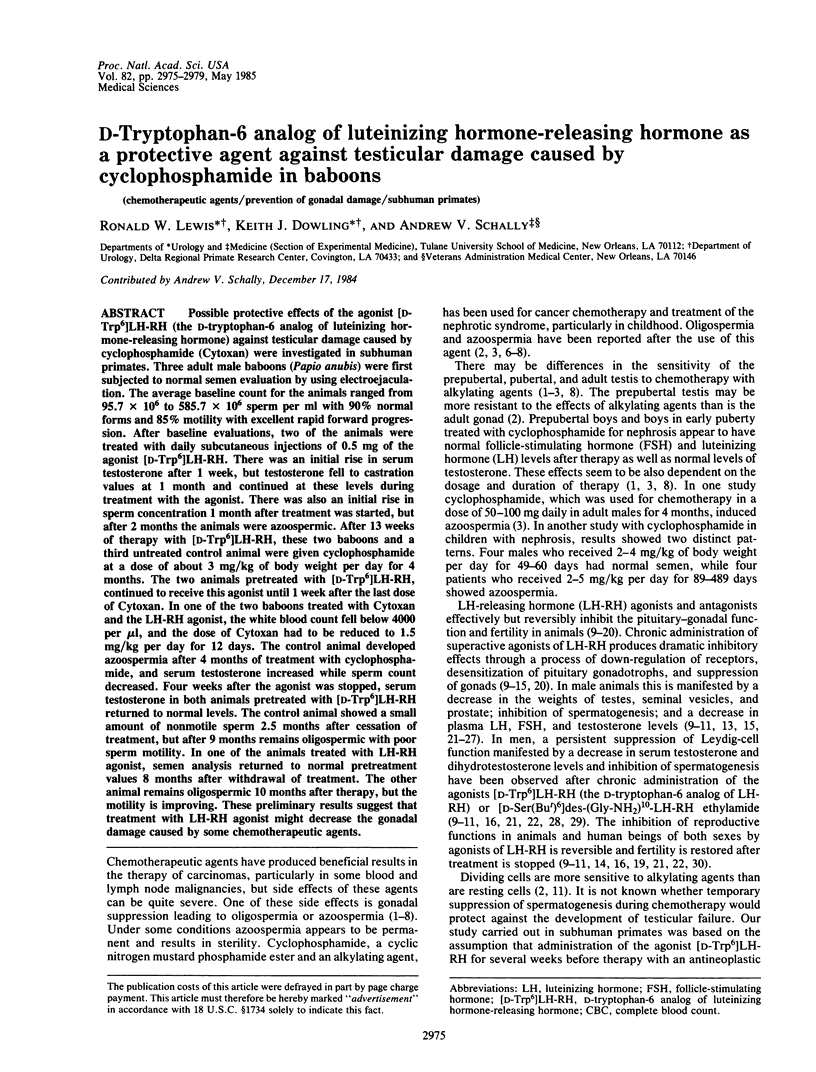
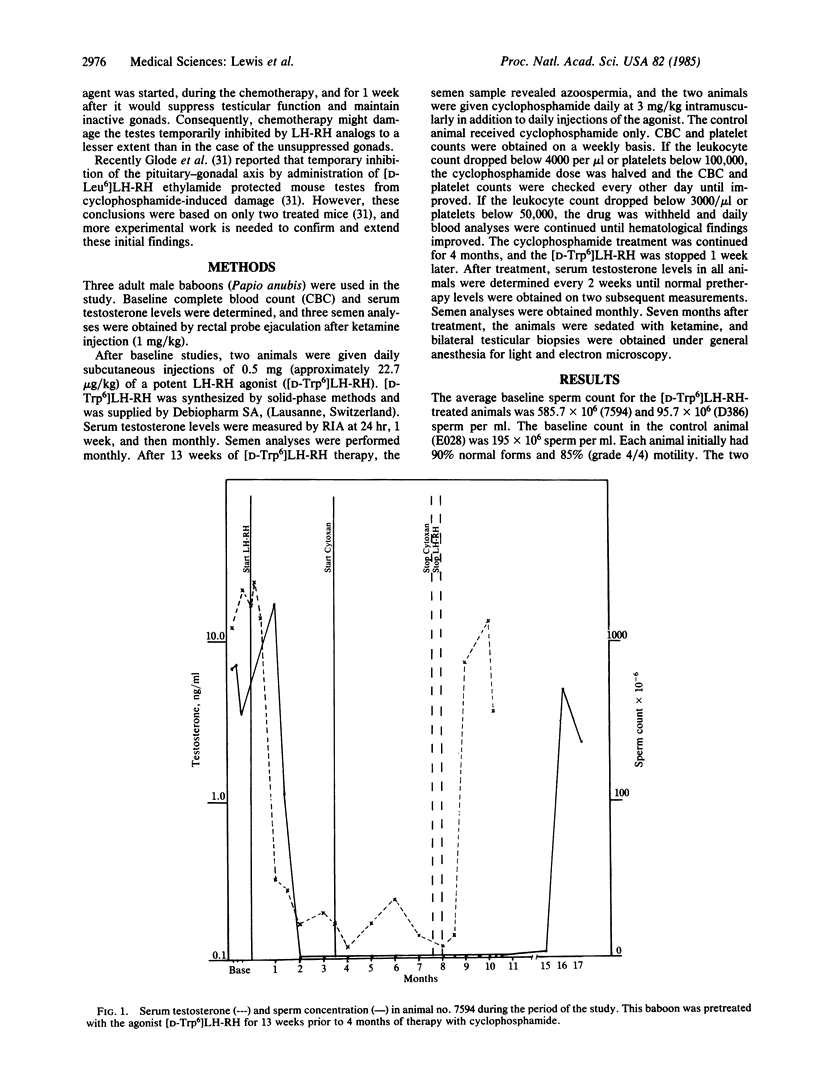
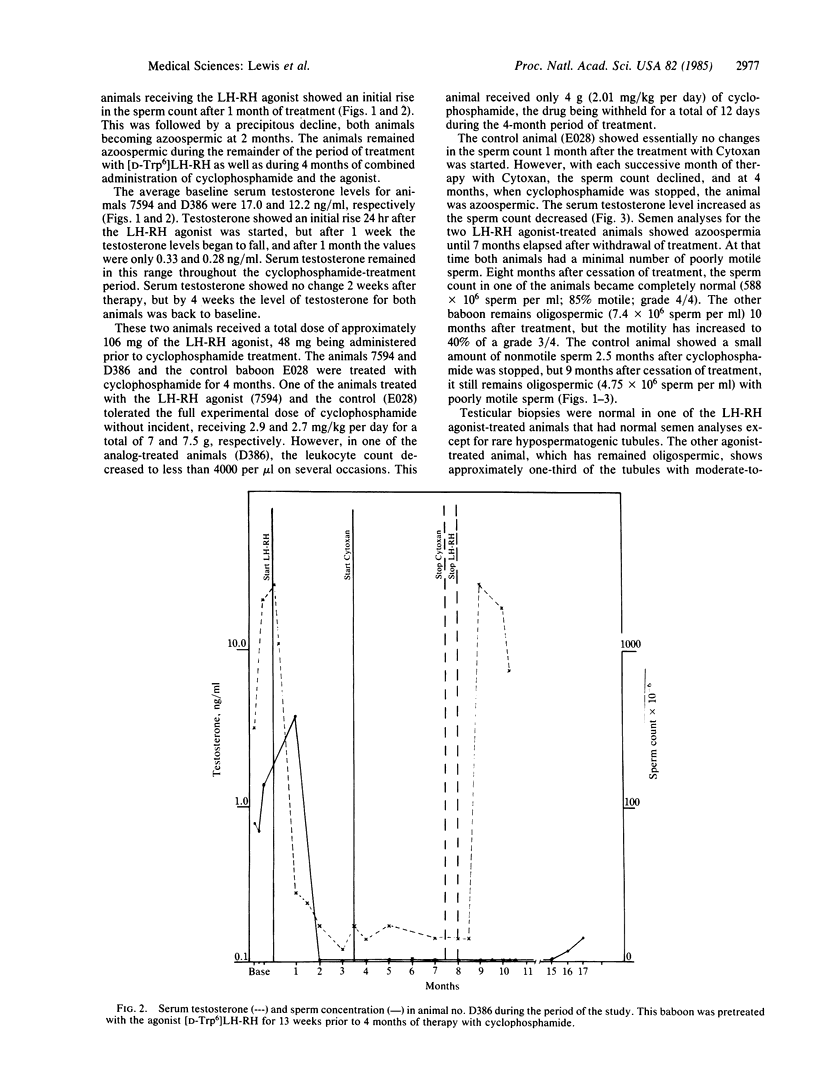
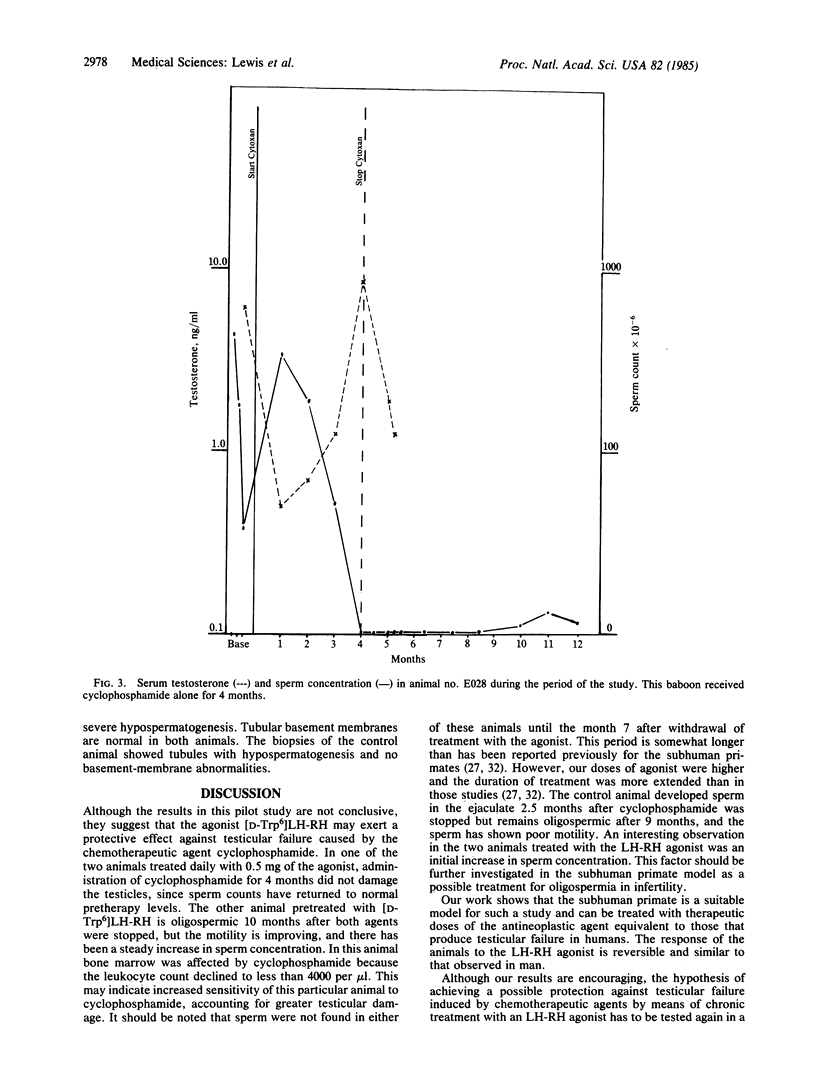
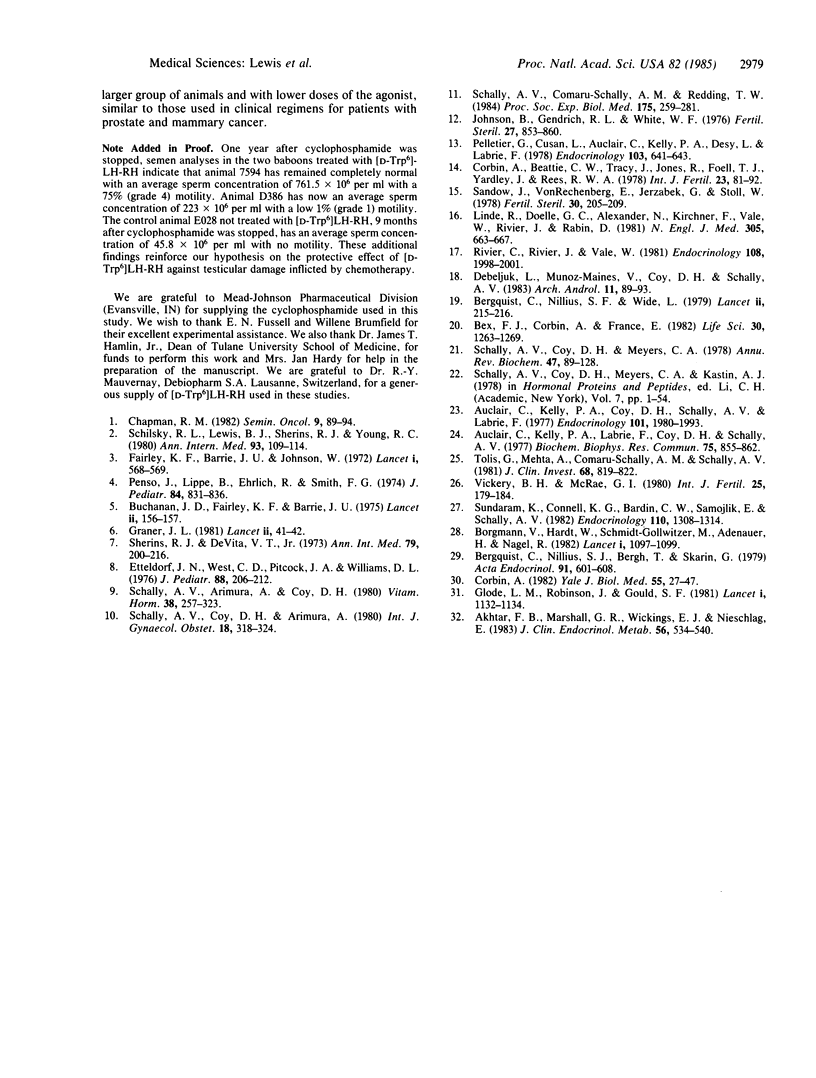
Selected References
These references are in PubMed. This may not be the complete list of references from this article.
- Akhtar F. B., Marshall G. R., Wickings E. J., Nieschlag E. Reversible induction of azoospermia in rhesus monkeys by constant infusion of a gonadotropin-releasing hormone agonist using osmotic minipumps. J Clin Endocrinol Metab. 1983 Mar;56(3):534–540. doi: 10.1210/jcem-56-3-534. [DOI] [PubMed] [Google Scholar]
- Auclair C., Kelly P. A., Labrie F., Coy D. H., Schally A. V. Inhibition of testicular luteinizing hormone receptor level by treatment with a potent luteinizing hormone-releasing hormone agonist of human chorionic gonadotropin. Biochem Biophys Res Commun. 1977 Jun 6;76(3):855–862. doi: 10.1016/0006-291x(77)91579-0. [DOI] [PubMed] [Google Scholar]
- Bergquist C., Nillius S. J., Bergh T., Skarin G., Wide L. Inhibitory effects on gonadotrophin secretion and gonadal function in men during chronic treatment with a potent stimulatory luteinizing hormone-releasing hormone analogue. Acta Endocrinol (Copenh) 1979 Aug;91(4):601–608. doi: 10.1530/acta.0.0910601. [DOI] [PubMed] [Google Scholar]
- Bergquist C., Nillius S. J., Wide L. Intranasal gonadotropin-releasing hormone agonist as a contraceptive agent. Lancet. 1979 Aug 4;2(8136):215–217. doi: 10.1016/s0140-6736(79)90235-6. [DOI] [PubMed] [Google Scholar]
- Bex F. J., Corbin A., France E. Resistance of the mouse to the antifertility effects of LHRH agonists. Life Sci. 1982 Apr 12;30(15):1263–1269. doi: 10.1016/0024-3205(82)90688-9. [DOI] [PubMed] [Google Scholar]
- Borgmann V., Hardt W., Schmidt-Gollwitzer M., Adenauer H., Nagel R. Sustained suppression of testosterone production by the luteinising-hormone releasing-hormone agonist buserelin in patients with advanced prostate carcinoma. A new therapeutic approach? Lancet. 1982 May 15;1(8281):1097–1099. doi: 10.1016/s0140-6736(82)92279-6. [DOI] [PubMed] [Google Scholar]
- Buchanan J. D., Fairley K. F., Barrie J. U. Return of spermatogenesis after stopping cyclophosphamide therapy. Lancet. 1975 Jul 26;2(7926):156–157. doi: 10.1016/s0140-6736(75)90059-8. [DOI] [PubMed] [Google Scholar]
- Corbin A., Beattie C. W., Tracy J., Jones R., Foell T. J., Yardley J., Rees R. W. The anti-reproductive pharmacology of LH-RH and agonistic analogues. Int J Fertil. 1978;23(2):81–92. [PubMed] [Google Scholar]
- Corbin A. From contraception to cancer: a review of the therapeutic applications of LHRH analogues as antitumor agents. Yale J Biol Med. 1982 Jan-Feb;55(1):27–47. [PMC free article] [PubMed] [Google Scholar]
- Debeljuk L., Maines V. M., Coy D. H., Schally A. V. Effect of a powerful antagonist of LH-RH on testicular function in prepubertal male rats. Arch Androl. 1983 Aug;11(1):89–93. doi: 10.3109/01485018308987466. [DOI] [PubMed] [Google Scholar]
- Etteldorf J. N., West C. D., Pitcock J. A., Williams D. L. Gonadal function, testicular histology, and meiosis following cyclophosphamide therapy in patients with nephrotic syndrome. J Pediatr. 1976 Feb;88(2):206–212. doi: 10.1016/s0022-3476(76)80983-3. [DOI] [PubMed] [Google Scholar]
- Fairley K. F., Barrie J. U., Johnson W. Sterility and testicular atrophy related to cyclophosphamide therapy. Lancet. 1972 Mar 11;1(7750):568–569. doi: 10.1016/s0140-6736(72)90358-3. [DOI] [PubMed] [Google Scholar]
- Glode L. M., Robinson J., Gould S. F. Protection from cyclophosphamide-induced testicular damage with an analogue of gonadotropin-releasing hormone. Lancet. 1981 May 23;1(8230):1132–1134. doi: 10.1016/s0140-6736(81)92301-1. [DOI] [PubMed] [Google Scholar]
- Graner J. L. Gonadal atrophy and azoospermia after cytotoxic drugs. Lancet. 1981 Jul 4;2(8236):41–42. doi: 10.1016/s0140-6736(81)90274-9. [DOI] [PubMed] [Google Scholar]
- Johnson E. S., Gendrich R. L., White W. F. Delay of puberty and inhibition of reproductive processes in the rat by a gonadotropin-releasing hormone agonist analog. Fertil Steril. 1976 Jul;27(7):853–860. doi: 10.1016/s0015-0282(16)41963-1. [DOI] [PubMed] [Google Scholar]
- Linde R., Doelle G. C., Alexander N., Kirchner F., Vale W., Rivier J., Rabin D. Reversible inhibition of testicular steroidogenesis and spermatogenesis by a potent gonadotropin-releasing hormone agonist in normal men: an approach toward the development of a male contraceptive. N Engl J Med. 1981 Sep 17;305(12):663–667. doi: 10.1056/NEJM198109173051203. [DOI] [PubMed] [Google Scholar]
- Pelletier G., Cusan L., Auclair C., Kelly P. A., Désy L., Labrie F. Inhibition of spermatogenesis in the rat by treatment with [D-Ala6, Des-Gly-NH210] LHRH ethylamide. Endocrinology. 1978 Aug;103(2):641–643. doi: 10.1210/endo-103-2-641. [DOI] [PubMed] [Google Scholar]
- Penso J., Lippe B., Ehrlich R., Smith F. G., Jr Testicular function in prepubertal and pubertal male patients treated with cyclophosphamide for nephrotic syndrome. J Pediatr. 1974 Jun;84(6):831–836. doi: 10.1016/s0022-3476(74)80758-4. [DOI] [PubMed] [Google Scholar]
- Rivier C., Rivier J., Vale W. Effect of a potent GnRH antagonist and testosterone propionate on mating behavior and fertility in the male rat. Endocrinology. 1981 May;108(5):1998–2001. doi: 10.1210/endo-108-5-1998. [DOI] [PubMed] [Google Scholar]
- Sandow J., Von Rechenberg W., Jerzabek G., Stoll W. Pituitary gonadotropin inhibition by a highly active analog of luteinizing hormone-releasing hormone. Fertil Steril. 1978 Aug;30(2):205–209. doi: 10.1016/s0015-0282(16)43461-8. [DOI] [PubMed] [Google Scholar]
- Schally A. V., Arimura A., Coy D. H. Recent approaches to fertility control based on derivative of LH-RH. Vitam Horm. 1980;38:257–323. doi: 10.1016/s0083-6729(08)60487-2. [DOI] [PubMed] [Google Scholar]
- Schally A. V., Comaru-Schally A. M., Redding T. W. Antitumor effects of analogs of hypothalamic hormones in endocrine-dependent cancers. Proc Soc Exp Biol Med. 1984 Mar;175(3):259–281. doi: 10.3181/00379727-175-41797. [DOI] [PubMed] [Google Scholar]
- Schally A. V., Coy D. H., Arimura A. LH-RH agonists and antagonists. Int J Gynaecol Obstet. 1980;18(5):318–324. doi: 10.1002/j.1879-3479.1980.tb00507.x. [DOI] [PubMed] [Google Scholar]
- Schally A. V., Coy D. H., Meyers C. A. Hypothalamic regulatory hormones. Annu Rev Biochem. 1978;47:89–128. doi: 10.1146/annurev.bi.47.070178.000513. [DOI] [PubMed] [Google Scholar]
- Schilsky R. L., Lewis B. J., Sherins R. J., Young R. C. Gonadal dysfunction in patients receiving chemotherapy for cancer. Ann Intern Med. 1980 Jul;93(1):109–114. doi: 10.7326/0003-4819-93-1-109. [DOI] [PubMed] [Google Scholar]
- Sherins R. J., DeVita V. T., Jr Effect of drug treatment for lymphoma on male reproductive capacity. Studies of men in remission after therapy. Ann Intern Med. 1973 Aug;79(2):216–220. doi: 10.7326/0003-4819-79-2-216. [DOI] [PubMed] [Google Scholar]
- Sundaram K., Connell K. G., Bardin C. W., Samojlik E., Schally A. V. Inhibition of pituitary-testicular function with [D-Trp6] luteinizing hormone-releasing hormone in rhesus monkeys. Endocrinology. 1982 Apr;110(4):1308–1314. doi: 10.1210/endo-110-4-1308. [DOI] [PubMed] [Google Scholar]
- Tolis G., Mehta A., Comaru-Schally A. M., Schally A. V. Suppression of androgen production by D-tryptophan-6-luteinizing hormone-releasing hormone in man. J Clin Invest. 1981 Sep;68(3):819–822. doi: 10.1172/JCI110320. [DOI] [PMC free article] [PubMed] [Google Scholar]
- Vickery B. H., McRae G. I. Effects of continuous treatment of male baboons with superagonists of LHRH. Int J Fertil. 1980;25(3):179–184. [PubMed] [Google Scholar]


